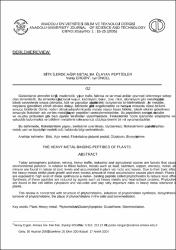| dc.contributor.author | Ergün, Nuray | |
| dc.contributor.author | Öncel, Işıl | |
| dc.date.accessioned | 2014-11-18T09:07:18Z | |
| dc.date.available | 2014-11-18T09:07:18Z | |
| dc.date.issued | 2005 | |
| dc.identifier.issn | 13023160 | |
| dc.identifier.uri | https://hdl.handle.net/11421/689 | |
| dc.description.abstract | Günümüzde atmosfer kirliliği, madencilik, yoğun trafik, fabrika ve tarımsal atıklar çevresel kirlenmeye sebep olan etmenlerdir. Bu etmenlere bağlı olarak kurşun, kadmiyum, bakır, civa, nikel, alüminyum gibi metaller doğada toksik seviyelerde ortaya çıkmakta, kök ve yapraklar aracılığı ile bitki bünyesinde biriktirilmektedir. Ağır metaller, meydana getirdikleri zehirli etkiden dolayı, bitkilerde gelişimi engellemekte ve hatta aşırı miktarda metal birikimi sonucu bitkilerde ölüme neden olmaktadır. Aşırı miktarda metale maruz kalan bitkiler, toksik etkinin giderilmesi amacıyla fitokelatin adı verilen metal bağlayan peptidleri sentezlemektedirler. Bu peptidlerin sentezi, ağır metaller ve ısı şoku proteinleri gibi bazı ajanlar tarafından uyarılmaktadır. Fitokelatinler hücre içerisinde sitoplazma ve vakuolde bulunmakta ve bitkilerin metallerle toleransında oldukça önemli bir rol oynamaktadırlar.
Bu derlemede, fitokelatinlerin yapısı, sentezinin uyarılması, biyosentezi, fitokelatinlerin geri dönüşümü , hücredeki yeri ve biyoiyileştirmedeki rolü hakkında bilgi verilmektedir. | en_US |
| dc.description.abstract | Today atmospheric pollution, mining, heavy traffic, industrial and agricultural wastes are factors that cause environmental pollution. In relation to these factors, metals such as lead, cadmium, copper, mercury, nickel, aluminium are found in nature at toxic levels and accumulated in plant via roots and leaves. Due to their toxic effect, the heavy metals inhibit plant growth and even excess amount of metal accumulation causes plant death. Plants that are exposed to high level of metal synthesize a metal- binding peptide called phytochelatin to reduce toxic effect. Synthesis of these peptides are induced by agents such as heavy metals and heat-schock proteins. Phytochelatins are found in the cell within cytoplasm and vacuoles and play very important roles in heavy metal tolerance in plants.
This review is concerned with structure of phytochelatins, induction of phytochelatin synthesis, biosynthesis, turnover of phytochelatins, the place of phytochelatins in the cells and bioremediation. | en_US |
| dc.language.iso | tur | en_US |
| dc.publisher | Anadolu Üniversitesi | en_US |
| dc.rights | info:eu-repo/semantics/openAccess | en_US |
| dc.subject | Bitki | en_US |
| dc.subject | Ağır Metal | en_US |
| dc.subject | Fitokelatin | en_US |
| dc.subject | Ὑ -Glutamil Peptid | en_US |
| dc.subject | Glutatyon | en_US |
| dc.subject | Biyoiyileştirme | en_US |
| dc.subject | Plant | en_US |
| dc.subject | Heavy Metal | en_US |
| dc.subject | Phytochelatin | en_US |
| dc.subject | Ὑ -Glutamyl Peptide | en_US |
| dc.subject | Glutathione | en_US |
| dc.subject | Bioremediation | en_US |
| dc.title | Bitkilerde Ağır Metal Bağlayan Peptidler | en_US |
| dc.title.alternative | The Heavy Metal-Binding Peptides of Plants | en_US |
| dc.type | article | en_US |
| dc.relation.journal | Anadolu Üniversitesi Bilim ve Teknoloji Dergisi A - Uygulamalı Bilimler ve Mühendislik | en_US |
| dc.relation.publicationcategory | Makale - Ulusal Hakemli Dergi - Kategorisiz | en_US |


















